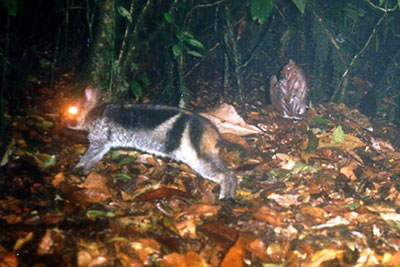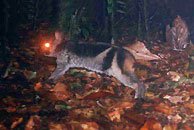Rare Sumatran Striped Rabbit Photographed
Posted by: Loren Coleman on April 8th, 2007

The Sumatran Striped Rabbit (Nesolagus netscheri) has been captured on film, again.
The appearances of the Sumatran striped rabbit are so rare that when seen in the West, many believe someone is pulling an Easter bunny joke. But indeed the appearance of one of these in the wilds of Indonesia has been breaking news at week. Here are the details and some background.
In 1972, one confirmed sighting was made of what was said to be a Sumatran Striped Rabbit. The last specimen was actually collected in 1916, and was presumed extinct until photographed with the TrailMaster remotecam in 1997, as seen above. Note what appears to be a flying fox (bat) on the ground behind the rabbit.

A unknown, at the time, relative, the Annamite striped rabbit – above – (Nesolagus timminsi) was discovered when three freshly hunted specimens were found by Rob Timmins in a Laotian meat market in 1995 and described in 2000. In the rainforest of the Annam Highlands of Laos and Vietnam, this rabbit has distinct brown stripes running down its back and along its face, with short ears, and a redder hindquarters than its Sumatran cousin.
Nesolagus timminsi
This current example of a striped rabbit being photographed was by remotecam trap in the rain forests of the Bukit Barisan National Park, Sumatra, Indonesia, according to researchers from the Wildlife Conservation Society. This is only the third time the striped rabbit has ever been recorded via trailcams in Indonesia; the first dates from 1998 in Kerinci Seblat National Park, and the second was taken from Bukit Barisan National Park in 2000.
Before the recent incidents, the last confirmed sighting by scientists of a living animal, as mentioned above, was dated from 1972, and only 15 specimens exist in museums, all dating from before 1929. It is currently listed as ‘Critically Endangered’ by the World Conservation Union (IUCN).

Nesolagus netscheri
The rabbit is only known to exist from forests along the mountainous spine of Sumatra, and was thought to be the only representative of its genus. Using the date 1999, the Wildlife Conservation Society states that “researchers discovered another striped rabbit in the Annamite Mountains that straddle Lao PDR and Vietnam. Although both species seem similar in appearance, genetic samples from both revealed the Sumatran and Annamite striped rabbits are closely related but separate species from one another. According to the findings, both species have been diverging for approximately 8 million years.”
The Wildlife Conservation Society ended their press release (honestly), by noting: “Researchers also report that no colored eggs or baskets were found at the study site.”
About Loren Coleman
Loren Coleman is one of the world’s leading cryptozoologists, some say “the” leading living cryptozoologist. Certainly, he is acknowledged as the current living American researcher and writer who has most popularized cryptozoology in the late 20th and early 21st centuries.
Starting his fieldwork and investigations in 1960, after traveling and trekking extensively in pursuit of cryptozoological mysteries, Coleman began writing to share his experiences in 1969. An honorary member of Ivan T. Sanderson’s Society for the Investigation of the Unexplained in the 1970s, Coleman has been bestowed with similar honorary memberships of the North Idaho College Cryptozoology Club in 1983, and in subsequent years, that of the British Columbia Scientific Cryptozoology Club, CryptoSafari International, and other international organizations. He was also a Life Member and Benefactor of the International Society of Cryptozoology (now-defunct).
Loren Coleman’s daily blog, as a member of the Cryptomundo Team, served as an ongoing avenue of communication for the ever-growing body of cryptozoo news from 2005 through 2013. He returned as an infrequent contributor beginning Halloween week of 2015.
Coleman is the founder in 2003, and current director of the International Cryptozoology Museum in Portland, Maine.

,.JPG/240px-Fenek_tal-istrixxi_ta'_Annam_(N._timminsi),.JPG)









Thats awesome. It appears as though this rabbit is still alive as a species and is indeed not extinct just yet.
Rabbits are quick to breed, must be many more in the jungle. bring some to the Bronx zoo for breeding purposes.
Or any other zoo?
Will the habitat support an increased population? Without being more familiar with their behaviours, it’s hard to justify dumping larger numbers into the wild.
Since they’ve only been seen three times since 1998, it doesn’t appear that doing more research is any more likely than finding a male and female as a breeding pair.
As special as it is to see one of these rabbits, has anyone else found the “flying fox” bat thing behind and to the right a little creepy? It almost looks like it is waving or posing for the picture. Or is the vampire shrinking back from the bright light, allowing the poor, innocent bunny the ability to escape? (I know, I know–flying foxes aren’t vampires, but it seems like that in this pic)
That bat is a bit strangely positioned…still a fascinating bit of news.
Maybe the bat thing is some sort of cryptid that they were actually trying to find and the rabbit was a bonus? 🙂 I think this is exciting news on a very elusive animal. But I wonder where its field of blurriness is? 🙂 Sorry to get off topic, but that pic is the kind of clear shot we need more of when it comes to Bigfoot.
It looks like a Chupacabra in the background. It’s squatting and waiting to pounce on the last living striped rabbit.
I’ve never seen a flying fox sitting on the ground like this, exposed to predators. Normally, when not in the air, they tend to stay in treetops. I think this is just some freak leaf/piece of wood formation (like so many sasquatch pictures).
I can’t see the flying fox.
I think the “bat” is a dead leaf (or leaves). If villagers can catch this bunny and bring him to market (dead), why can’t someone offer them a few bucks to catch a few live members of the species that could be taken somewhere to breed?